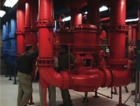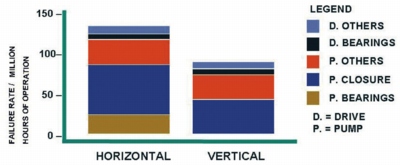Low maintenance costs start with the design

Fig. 2:Over 30 years of operating experience with these split-coupled inline pumps in Canada has made it possible to assess life-cycle costs in practice.
The key to minimising life-cycle costs is to think about maintenance at the design stage. Wayne Rose shares some ideas.The costs of maintenance and the long-term reliability of plant are largely pre-determined by choices made during design and specification. The aspects of system design which have the greatest impact could be summarised as follows. • Ease and cost of routine maintenance.
• Inherent reliability arising from design. • Control philosophy.
Routine maintenance For large pumps, seal replacement remains a key area of routine maintenance and a major contributor to total lifecycle cost. One design decision therefore involves comparing close coupled pumps with their split-coupled alternatives.
 |
Fig. 1: Compared with disconnecting and removing a large motor from a pump, a split coupling on the drive shaft makes it much easier and quicker to carry out the routine work of replacing the seal. |
The benefit of a split-coupled vertical inline pump is that the seal can be changed without removing the motor and rotor assembly (Fig. 1). This work involves removing the coupling guard to access the coupling and then removing the coupling bolts and splitting the coupling. The set screws on the seal rotating element are then loosened so that it can be slid from the pump shaft. Disconnecting the seal flush line and removing the gland-plate bolts then enables the gland plate and seal to be removed. The new seal is installed by reversing the process. The rigid coupling design retains factory alignment and does not require field adjustment. This pump design reduces plant downtime significantly. Having to remove the heavy components on a standard pump to change a seal means labour cost outlay and the requirement for heavy lifting gear. On a standard pump, alignment is also always necessary following a seal change. The split-coupled vertical inline pump removes this service cost which, in turn, has a major impact on lifecycle costs. For example, a seal change on a standard base-mounted or vertical inline 200 mm pump would be expected to take seven hours, requiring more than one person and lifting gear. A seal change on a split coupled vertical inline 200mm pump would be expected to take just one and a half hours, requiring one person and no lifting gear. Lifecycle costs for pumps in the Armstrong range can be compared using the Verticalc* section of our pump specification software to automatically calculate all anticipated costs associated with specific pumps, including build costs, fittings and maintenance costs. Potential savings are given for both installation and lifecycle costs. Inherent reliability When it comes to lifetime reliability, it is tempting to see all pumps as much of a muchness — which can be a dangerous assumption Certain pump technologies and approaches to pump design offer the specifier inherently improved reliability. For example, in a vertical inline pump, components are dynamically balanced to reduce vibration and hydraulic noise. The benefits include smooth operation and, hence, longer pump life. The only bearings are in the motor, reducing the chance of bearing failure compared to some end-suction pumps. The balanced external seal design prevents excessive pressure on the seal faces and so extends internal seal life, typically by two to three times. Seal environment accessories are also available to extend seal life even further.
 |
Fig. 3: Vertical inline pumps are much more reliable than horizontal inline pumps, as this analysis based on failure rate per million hours of operation. |
This is not new technology, and these pumping solutions have been applied in the UK and worldwide for a number of years. Huge split-coupled pumps were installed in First Canadian Place in Toronto in 1975 and are still serving this 72-storey building over 30 years later. Experience of this design approach for such an extended period of time has made it possible for us to assess lifecycle costs in practice. Fig. 3 shows a comparison between horizontal and vertical pump designs based on failure rate per million hours of operation. The vertical model is 158% more reliable than base-mounted alternatives, largely due to improved pump closure performance and the absence of pump bearings.
Control philosophy In comparison, decisions regarding control philosophy and its impact on lifecycle cost are in their infancy. Thinking with regard to control of HVAC systems is changing in the light of the latest technology for balancing and managing building load. For chillers and condensing boilers in particular, the traditional approaches to managing load (namely starting each chiller or boiler in series as required until the load is met) have proved hopelessly outdated for today’s high-efficiency equipment. There is a growing appreciation of the energy-efficiency benefits of balancing load across the system, rather than, for example, ramping boilers up and down in unison. This ‘full-system control’ is made possible by integrating components such as variable-speed pumps, boilers and pressurisation units so that they work in collaboration with one another instead of in isolation. This control philosophy greatly reduces the need to start up and shut down system components, reducing wear and tear and contributing to longer life and lower lifecycle cost. In summary, there are a number of frequently overlooked opportunities to improve the long-term performance of HVAC systems. The culprit is habit. A specification will often call for an industry-standard piece of equipment, but there is very often a far better solution which will reduce lifecycle costs. It is just a matter of asking the appropriate questions and making the best design decisions.
Wayne Rose is marketing manager of Armstrong. Fig. 1: Compared with disconnecting and removing a large motor from a pump, a split coupling on the drive shaft makes it much easier and quicker to carry out the routine work of replacing the seal.
Related links:










